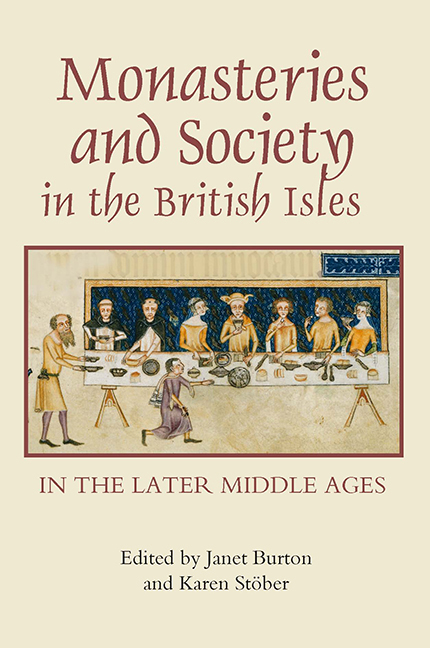Book contents
- Frontmatter
- Contents
- List of illustrations
- Acknowledgements
- List of contributors
- Abbreviations
- Introduction
- The Meeting of the Worlds
- Religious Houses and their Patrons and Benefactors
- 5 Patronage, prestige and politics: The Observant Franciscans at Adare
- 6 The Augustinian priory of Wombridge and its benefactors in the later Middle Ages
- 7 The rising price of piety in the later Middle Ages
- Female Communities: Nuns, Abbesses and Prioresses
- Monasteries and Education
- Monasteries and Urban Space
- Religious Houses in the Regions
- Index of Religious Houses mentioned in the text
- Index
- Miscellaneous Endmatter
6 - The Augustinian priory of Wombridge and its benefactors in the later Middle Ages
from Religious Houses and their Patrons and Benefactors
Published online by Cambridge University Press: 24 October 2017
- Frontmatter
- Contents
- List of illustrations
- Acknowledgements
- List of contributors
- Abbreviations
- Introduction
- The Meeting of the Worlds
- Religious Houses and their Patrons and Benefactors
- 5 Patronage, prestige and politics: The Observant Franciscans at Adare
- 6 The Augustinian priory of Wombridge and its benefactors in the later Middle Ages
- 7 The rising price of piety in the later Middle Ages
- Female Communities: Nuns, Abbesses and Prioresses
- Monasteries and Education
- Monasteries and Urban Space
- Religious Houses in the Regions
- Index of Religious Houses mentioned in the text
- Index
- Miscellaneous Endmatter
Summary
The extent and richness of the late fifteenth-century cartulary of the Augustinian priory of St Leonard at Wombridge (BL, MS Egerton 3712) means that for a relatively ‘unexceptional’ community, in terms of the numbers of brethren and value of endowments, it is remarkably well documented. The majority of donations to Wombridge occurred from the thirteenth century onwards, when the canons resolutely built up and maintained their properties and rights, chiefly within close proximity to the priory. Moreover, during the late medieval period the community not only attracted benefactions from its patrons, but also from a wide circle of knightly families holding local lordships and relatively small estates, who could be regarded, in the words of Una Rees, as the ‘natural benefactors’ of the priory. The expansion of the community's estates and revenue, which accelerated from the mid thirteenth century onwards, was to a significant extent the result of a dynamic combination of a pro-active and accommodating religious community, and the continued donations of benefactors. At the heart of this, in essence, was the close and enduring relationship forged between the priory and its local lay supporters.
The community venerating St Leonard at Wombridge was the second Augustinian house established in Shropshire, after Haughmond Abbey which was founded between 1125 and 1136. Owing to the tenurial and socio-political influence, and religious aspirations, of the earls and constables of Chester, royal servants and their vassals and kin, the canons regular of St Augustine appeared in the north-west of the diocese of Coventry and Lichfield early in their movement's development. Beginning with the foundation of Runcorn by William the constable in 1115, a further six houses were established by the end of Henry I's reign. By c. 1204 twelve communities of canons and one of canonesses had been founded in the region. Despite this not inconsiderable presence within the diocese, which can be paralleled in other areas of Britain, the Augustinian canons remain one of the least studied of the medieval religious orders. Since J. C. Dickinson's influential work and David Robinson's geographical survey, no major study has appeared, while there have been roughly a dozen papers relating to the Black Canons.
- Type
- Chapter
- Information
- Publisher: Boydell & BrewerPrint publication year: 2008

